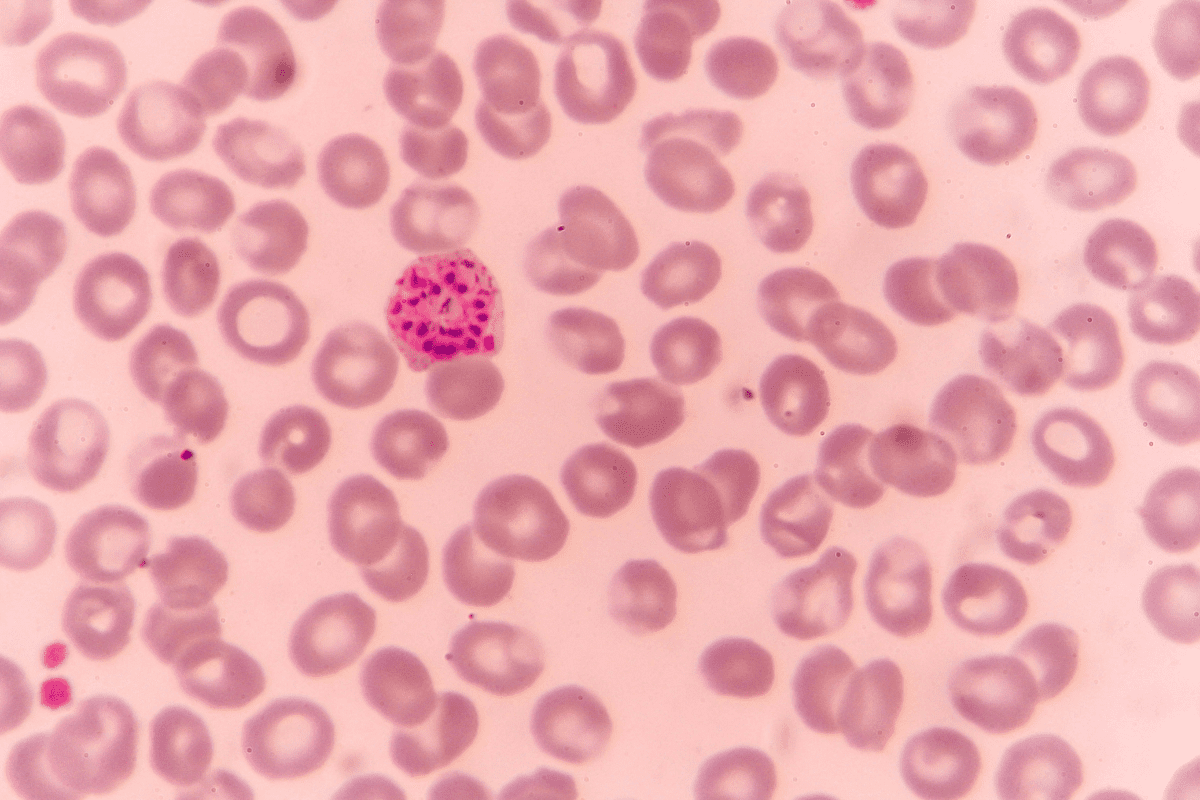
Is multiple sclerosis caused by a malaria-like parasite?
A recent study found that the malaria drug hydroxychloroquine (HCQ) significantly slowed down the progression of disability in people with primary progressive MS (PPMS). This post will discuss:
-
- What protists are and how they infect us
- Highlights of this study
- Provide compelling evidence linking MS and a malaria / babesia type parasite
- Symptoms of this parasite
Protists and how they infect us.
Protists are single celled parasites such as plasmodia, babesia, giardia and amoebas. They cause human diseases like malaria, Trypanosomiasis (African sleeping sickness), Leishmaniasis, toxoplasmosis and amoebic dysentery.
The protist babesia has been linked to multiple sclerosis. Watch my video Multiple Sclerosis and the Parasite Babesia
Many protists are spread through biting insects – mosquitoes, ticks and biting flies.
Protist infections are often misdiagnosed.
Malaria and Babesia protists infect red blood cells (RBCs) so they can’t move freely in blood vessels and end up sticking to blood vessel walls. In time, infected RBCs enter the central nervous system (CNS) causing cerebral malaria.
Study: Malaria Drug May be a Promising Treatment for Primary Progressive Multiple Sclerosis[i]
In September 2021, the study Hydroxychloroquine for Primary Progressive Multiple Sclerosis was published by researchers at the University of Calgary AB, Canada. Scientists at this university are leaders in publishing important studies about the microbiome and MS.
Normally at least 40% or 14 of the 35 PPMS participants should have experienced a decline in their ability to walk over the 18 months of the study, but at the end of this trial of HCQ, only 8 got worse.
They found that the antimalarial drug hydroxychloroquine (HCQ) reduced the activity of immune cells in the central nervous system and had neuroprotective effects in vitro.
Participants in the study took 200 mg HCQ twice a day for 18 months. This is a typical dose of HCQ used to treat Lupus and rheumatoid arthritis (RA).
Their conclusion – “…in people with PPMS, HCQ treatment was associated with reduced disability worsening. HCQ is a promising treatment candidate for PPMS and should be investigated further in randomized controlled clinical trials
The History of Multiple Sclerosis and Malaria
There are about 75 papers dating back to the 1880‘s where physicians and laboratorians discovered a malaria-like organism in patients with MS. Malaria has long been known to cause a demyelinating disease of the central nervous system similar to multiple sclerosis.
In 1899, Dr. Mannaberg was likely the first to believe that MS was caused by a malarial type infection. “According to him, a symptom-complex resembling MS played a major role in malaria.” [ii]
A two-part scientific review discussed the above research and the fact that antimalarial drugs were used in the 1920’s and early 1930’s in MS patients who experienced significant symptom improvements.[iii]
Later, Dr. Fry the founder of Fry Laboratories, discovered a new type of protist in MS patients. At first, he thought it was the protist babesia but after much research he discovered that it was actually “a malaria like organism that [forms] biofilm communities in the blood and has an extremely complex lifecycle. It is a blood loving parasite. After mapping the genome, he discovered that it is a new type of protist similar to malaria and babesia but more complex genetically, similar to a human’s parasitic worm and a protozoan.”[iv]
Symptoms and clinical findings of malaria infections[v]
Common symptoms can include:
- Fever
- Chills
- Sweats
- Headaches
- Nausea and vomiting
- Body aches
- Feeling unwell
Clinical findings may include:
- Elevated temperatures
- Perspiration
- Weakness
- Enlarged spleen
- Mild jaundice
- Enlarged liver
- Increased respiratory rate
- Parasites in the blood
- Anemia
- Decreased platelets (thrombocytopenia)
- Elevated bilirubin
- Elevated aminotransferases
Severe malaria can include:
- Organ failure
- Abnormalities in the patient’s blood or metabolism
- Cerebral malaria, with abnormal behavior, impairment of consciousness, seizures, coma, or other neurologic abnormalities
- Severe anemia due to hemolysis (destruction of the red blood cells)
- Hemoglobinuria (hemoglobin in the urine) due to hemolysis
- Acute respiratory distress syndrome (ARDS), an inflammatory reaction in the lungs that inhibits oxygen exchange, which may occur even after the parasite counts have decreased in response to treatment
- Abnormalities in blood coagulation
- Low blood pressure caused by cardiovascular collapse
- Acute kidney injury
- Hyperparasitemia, where more than 5% of the red blood cells are infected by malaria parasites
- Metabolic acidosis (excessive acidity in the blood and tissue fluids), often in association with hypoglycemia
- Severe malaria is a medical emergency and should be treated urgently and aggressively.
- Hearing loss and tinnitus[vi]
- Balance issues – dizziness
- Paralysis
Malaria targets the skeletal muscle system, leading to symptoms, such as muscle aches, muscle spasms, muscle fatigue, muscle pain, and muscle weakness. Malaria also causes parasitic obstruction of blood flow in the coronary.[vii]
In severe malaria, the infected red blood cells cause an obstruction of blood flow and can starve tissues of oxygen.[viii]
Hydroxychloroquine adverse effects – Hydroxychloroquine is used to treat lupus and rheumatoid arthritis. If you would like to talk to your doctor about taking this treatment, please also research the adverse effects. For example, HCQ can damage the retina in your eyes and therefore it’s important to have regular eye exams and pay attention to any negative symptoms in your eyes or vision while taking HCQ.
The dose of hydroxychloroquine prescribed in this study will not cure multiple sclerosis. It may discourage the growth of the protists, provide some symptom relief and slow down the progression of MS in some people.
If we want to recover from MS, we must use more effective treatments for this malaria type protist and also consider other parasites that are causing our symptoms while following a holistic approach.
In summary, there is substantial evidence that a malaria type protist is one of the most important infections causing multiple sclerosis. Why is over 100 years of compelling research ignored?
The improvements to PPMS patients in just 18 months of using HCQ, were far more significant than those experienced as a result of using any other MS disease modifying drug.
I commend this research team at the University of Calgary, Alberta Canada. Keep an eye on their work and support them.
Also, please share this blog post with your practitioners and MS groups to help us change the way that multiple sclerosis and other chronic diseases are treated.
There are Real Solutions for MS Today!
To restore health, we must focus on treating the cause of inflammation, which are parasites. First, identify the enemy (parasites), then support the body and treat the parasites while following a holistic approach. When parasitic infections are treated effectively, we can overcome inflammation or disease.
If you’re frustrated with the fact that our standard of care STILL doesn’t offer a real solution for treating MS, then click on the link below to watch Pam Bartha’s free masterclass training and discover REAL solutions that have allow Pam and many others to live free from MS symptoms.
CLICK Here to watch Pam’s masterclass training
Or take the Health Blocker Quiz to see if you could have parasite infections
References:
[i] https://onlinelibrary.wiley.com/doi/10.1002/ana.26239
[ii] https://jeffreydachmd.com/wp-content/uploads/2015/06/Stephen-Fry-Interview-on-Biofilms-and-Protomyxzoa-Rheumatica-Marc-Braman.pdf
[iii] https://pubmed.ncbi.nlm.nih.gov/11516218/
https://pubmed.ncbi.nlm.nih.gov/11516219/
[iv] https://jeffreydachmd.com/wp-content/uploads/2015/06/Stephen-Fry-Interview-on-Biofilms-and-Protomyxzoa-Rheumatica-Marc-Braman.pdf
[v] https://www.cdc.gov/malaria/about/disease.html
[vi] https://pubmed.ncbi.nlm.nih.gov/27578030/
[vii] https://malariajournal.biomedcentral.com/articles/10.1186/s12936-016-1577-y
[viii] https://malariajournal.biomedcentral.com/articles/10.1186/s12936-016-1577-y

Clinically diagnosed with multiple sclerosis at the age of 28, Pam chose an alternative approach to recovery. Now decades later and still symptom free, she coaches others on how to treat the root cause of chronic disease, using a holistic approach. She can teach you how, too.
Pam is the author of Become a Wellness Champion and founder of Live Disease Free. She is a wellness expert, coach and speaker.
The Live Disease Free Academy has helped hundreds of Wellness Champions in over 15 countries take charge of their health and experience profound improvements in their life.

